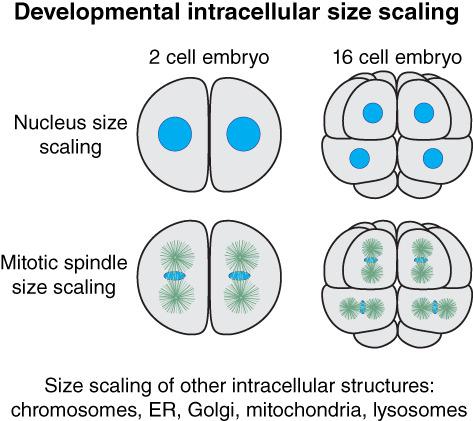当前位置:
X-MOL 学术
›
WIREs Mech. Dis.
›
论文详情
Our official English website, www.x-mol.net, welcomes your feedback! (Note: you will need to create a separate account there.)
Organelle size scaling over embryonic development.
WIREs Mechanisms of Disease ( IF 3.1 ) Pub Date : 2020-01-31 , DOI: 10.1002/wdev.376 Chase C Wesley 1 , Sampada Mishra 1 , Daniel L Levy 1
WIREs Mechanisms of Disease ( IF 3.1 ) Pub Date : 2020-01-31 , DOI: 10.1002/wdev.376 Chase C Wesley 1 , Sampada Mishra 1 , Daniel L Levy 1
Affiliation

|
Cell division without growth results in progressive cell size reductions during early embryonic development. How do the sizes of intracellular structures and organelles scale with cell size and what are the functional implications of such scaling relationships? Model organisms, in particular Caenorhabditis elegans worms, Drosophila melanogaster flies, Xenopus laevis frogs, and Mus musculus mice, have provided insights into developmental size scaling of the nucleus, mitotic spindle, and chromosomes. Nuclear size is regulated by nucleocytoplasmic transport, nuclear envelope proteins, and the cytoskeleton. Regulators of microtubule dynamics and chromatin compaction modulate spindle and mitotic chromosome size scaling, respectively. Developmental scaling relationships for membrane‐bound organelles, like the endoplasmic reticulum, Golgi, mitochondria, and lysosomes, have been less studied, although new imaging approaches promise to rectify this deficiency. While models that invoke limiting components and dynamic regulation of assembly and disassembly can account for some size scaling relationships in early embryos, it will be exciting to investigate the contribution of newer concepts in cell biology such as phase separation and interorganellar contacts. With a growing understanding of the underlying mechanisms of organelle size scaling, future studies promise to uncover the significance of proper scaling for cell function and embryonic development, as well as how aberrant scaling contributes to disease.
中文翻译:

细胞器大小随胚胎发育成比例变化。
没有生长的细胞分裂导致早期胚胎发育过程中细胞大小逐渐减小。细胞内结构和细胞器的大小如何与细胞大小成比例,这种比例关系的功能含义是什么?模式生物,特别是秀丽隐杆线虫、黑腹果蝇、非洲爪蟾和Mus musculus小鼠,提供了对细胞核、有丝分裂纺锤体和染色体发育大小缩放的见解。核大小受核质转运、核被膜蛋白和细胞骨架的调节。微管动力学和染色质压实的调节器分别调节纺锤体和有丝分裂染色体大小缩放。尽管新的成像方法有望纠正这种缺陷,但对膜结合细胞器(如内质网、高尔基体、线粒体和溶酶体)的发育尺度关系的研究较少。虽然调用限制组件和装配和拆卸的动态调节的模型可以解释早期胚胎中的某些尺寸缩放关系,研究新概念在细胞生物学中的贡献将是令人兴奋的,例如相分离和细胞器间接触。随着对细胞器大小缩放的潜在机制的日益了解,未来的研究有望揭示适当缩放对细胞功能和胚胎发育的重要性,以及异常缩放如何导致疾病。
更新日期:2020-01-31
中文翻译:

细胞器大小随胚胎发育成比例变化。
没有生长的细胞分裂导致早期胚胎发育过程中细胞大小逐渐减小。细胞内结构和细胞器的大小如何与细胞大小成比例,这种比例关系的功能含义是什么?模式生物,特别是秀丽隐杆线虫、黑腹果蝇、非洲爪蟾和Mus musculus小鼠,提供了对细胞核、有丝分裂纺锤体和染色体发育大小缩放的见解。核大小受核质转运、核被膜蛋白和细胞骨架的调节。微管动力学和染色质压实的调节器分别调节纺锤体和有丝分裂染色体大小缩放。尽管新的成像方法有望纠正这种缺陷,但对膜结合细胞器(如内质网、高尔基体、线粒体和溶酶体)的发育尺度关系的研究较少。虽然调用限制组件和装配和拆卸的动态调节的模型可以解释早期胚胎中的某些尺寸缩放关系,研究新概念在细胞生物学中的贡献将是令人兴奋的,例如相分离和细胞器间接触。随着对细胞器大小缩放的潜在机制的日益了解,未来的研究有望揭示适当缩放对细胞功能和胚胎发育的重要性,以及异常缩放如何导致疾病。


























 京公网安备 11010802027423号
京公网安备 11010802027423号